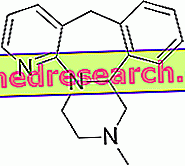Mirtazapine is a drug belonging to the class of specific serotonergic and noradrenergic antidepressants (NaSSA). It differs from TCAs, SSRIs and NSRIs (respectively, tricyclic antidepressants, selective serotonin reuptake inhibitors and noradrenaline and serotonin reuptake inhibitors) as it does not act directly on noradrenaline and serotonin receptors, but acts in a live.
Indications
For what it uses

Mirtazapina - Chemical Structure
The use of mirtazapine is indicated for the treatment of major depression in adult patients.
Warnings
Depression increases the risk of suicidal thoughts, self-harm and suicide. Since the improvement of these symptoms may not occur in the first periods of treatment with mirtazapine, it is good to monitor patients until the above improvement is achieved.
Mirtazapine should not be used for the treatment of depression in children and adolescents under 18 years of age.
Caution should be used in the administration of mirtazapine in patients who suffer - or have suffered - from seizure disorders.
If patients treated with mirtazapine develop jaundice, treatment with the drug should be discontinued.
The use of mirtazapine in patients with schizophrenia may cause a worsening of psychotic symptoms.
The use of mirtazapine should be discontinued if the patient enters a manic phase.
In diabetic patients - being treated with mirtazapine - an adjustment in the dose of insulin and / or hypoglycemic agents administered may be necessary.
Caution should be used in the administration of mirtazapine in patients with pre-existing cardiac or renal diseases.
Attention should be paid to the administration of mirtazapine in patients with glaucoma.
If signs of infection or high unexplained fever occur, contact a doctor immediately; these symptoms, in fact, could be signs related to possible dysfunctions of the system responsible for the production of blood cells (hemolymphopoietic system).
Interactions
Mirtazapine should not be taken concurrently with MAOI (monoamine oxidase inhibitors). If it is necessary to start a MAOI-based therapy, a period of at least two weeks must elapse after the last cranberry intake.
Concomitant administration of mirtazapine and the following drugs may lead to the onset of serotonin syndrome:
- SSRI antidepressants;
- Venlafaxine (an NSRI);
- Tryptophan ;
- Triptans, drugs used to treat migraine;
- Tramadol, an opioid painkiller;
- Linezolid, an antibiotic;
- Lithium, a drug used for the treatment of bipolar disorder;
- Hypericum based preparations (or St. John's wort, a plant with antidepressant properties).
Mirtazapine blood concentration can be increased by drugs such as:
- Nefazodone, an antidepressant;
- Erythromycin, an antibiotic;
- Ketoconazole, an antifungal drug;
- Ritonavir, an antiviral drug used to treat HIV;
- Cimetidine, a drug used to treat gastric ulcer.
Mirtazapine may increase the sedative effect of drugs, such as benzodiazepines, olanzapine (a drug used to treat schizophrenia), cetirizine (an antihistamine) and morphine .
Drugs used for epilepsy - such as carbamazepine and phenytoin - and drugs used to treat tuberculosis - such as rifampicin - can cause a decrease in mirtazapine blood levels, resulting in a decrease in its therapeutic efficacy.
Mirtazapine may increase the anticoagulant effect of warfarin .
The combination of mirtazapine with alcoholic beverages should be avoided.
Side effects
Mirtazapine can induce many side effects. The type and intensity of adverse effects, however, vary from person to person based on sensitivity to the drug that each individual has.
The following are the main side effects that may occur during mirtazapine therapy.
Bone marrow depression (myelosuppression)
Mirtazapine can cause myelosuppression resulting in reduced production of blood cells, which can lead to:
- Anemia (reduced amount of hemoglobin in the blood);
- Leukopenia (reduced number of white blood cells) with consequent increased susceptibility to infection contraction;
- Plateletopenia (reduced number of platelets) leading to bruising and abnormal bleeding with an increased risk of bleeding.
Psychiatric disorders
Mirtazapine therapy can cause psychiatric disorders, such as:
- Succidary ideas and / or suicidal behavior;
- Confusion;
- Vivid dreams;
- Nightmares;
- Anxiety;
- Mania;
- agitation;
- Hallucinations;
- Aggression;
- Sleepwalking.
Endocrine disorders
Mirtazapine therapy may cause the syndrome of inappropriate secretion of the antidiuretic hormone (SIADH).
Nervous system disorders
Treatment with mirtazapine may cause the onset of:
- Convulsions;
- Tremors;
- dizziness;
- Headache;
- Drowsiness;
- Lethargy;
- Dizziness;
- Oral paresthesia (alteration of the sensitivity of the mouth, generally perceived as a tingling);
- Speech disorders.
Skin and subcutaneous tissue disorders
Following the use of mirtazapine, severe skin manifestations can occur such as Stevens-Johnson syndrome (a variant of polymorphic erythema) and toxic epidermal necrolysis. Furthermore, skin rashes, rashes, itching, burning, stinging or tingling can occur. Mirtazapine can also cause bullous dermatitis and erythema multiforme.
Hepatobiliary disorders
Treatment with mirtazapine may cause liver function disorders and promote the appearance of jaundice.
Gastrointestinal disorders
Treatment with mirtazapine may cause nausea, vomiting, diarrhea and pancreatitis. In addition, the drug can cause dry mouth and swollen mouth.
Serotonin syndrome
This side effect may occur especially if mirtazapine is taken in conjunction with medications that can in turn increase serotonergic transmission (see the "Interaction with other drugs" section).
Serotonin syndrome can also be defined as a serotonin poisoning and is characterized by an excess of serotonin activity in the central nervous system. This syndrome may present with symptoms such as unexplained fever, increased salivation, sweating, increased heart rate, diarrhea, hyperactive reflexes, uncontrollable muscle contractions, tremor, restlessness, mood swings and unconsciousness.
Other side effects
Other side effects that may occur following the intake of mirtazapine are:
- Increased appetite and body weight;
- Myalgia and / or arthralgia;
- Back pain;
- Hypotension;
- Orthostatic hypotension (ie a drop in blood pressure when moving from a lying or sitting position to an upright position);
- Ankle and foot edema;
- Restless legs syndrome;
- Fatigue;
- Syncope (transient loss of consciousness caused by cerebral hypoperfusion);
- Myoclonia (short and involuntary contraction of a muscle or a group of muscles);
- Hyponatremia, ie a reduction in blood sodium levels.
Overdose
In case of mirtazapine overdose it is necessary to contact a doctor immediately or go immediately to the nearest hospital. Symptoms that may occur after taking an overdose include drowsiness, disorientation and an increase in heart rate.
Action mechanism
The antidepressant action of mirtazapine is due to the inhibition of presynaptic α 2 receptors placed on the presynaptic nerve termination of the noradrenergic type. These receptors, in fact, when activated they trigger a mechanism called negative feedback that inhibits the release of noradrenaline itself. By blocking them, mirtazapine is able to increase the release of norepinephrine from the nerve termination.
Furthermore, mirtazapine is an antagonist of 5-HT 2 and 5-HT 3 receptors, serotonin (5-HT) receptors that play a role in depressive disorders.
Mode of Use - Posology
Mirtazapine is available for oral administration as tablets to be swallowed whole with some water, or in the form of orodispersible tablets.
It is preferable to take the tablets at the same time of day.
The dosage must be established by the doctor on an individual basis for each patient.
However, the doses of mirtazapine usually used are 15-30 mg of drug to be taken once a day. The dose can be increased - at the discretion of the doctor - up to 45 mg of active ingredient per day.
Dosage adjustments may be necessary in elderly patients and in patients with liver and / or kidney disease.
Pregnancy and breastfeeding
Before taking mirtazapine, pregnant women - both proven and presumed - and mothers who are breast-feeding should definitely seek medical advice.
Furthermore - if the drug was taken until shortly before delivery - the newborn must be carefully monitored to identify any adverse effects.
Contraindications
The use of mirtazapine is contraindicated in the following cases:
- Known hypersensitivity to mirtazapine;
- In case of ongoing MAOI therapy;
- In case of MAOI therapy interrupted for less than two weeks;
- In children and adolescents under the age of 18.



